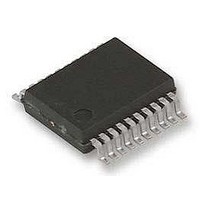ATA5743P6-TKQY 19 Atmel, ATA5743P6-TKQY 19 Datasheet - Page 10

ATA5743P6-TKQY 19
Manufacturer Part Number
ATA5743P6-TKQY 19
Description
RF Receiver UHF ASK / FSK Receiver
Manufacturer
Atmel
Type
Receiverr
Datasheet
1.ATA5743P3-TGQY.pdf
(43 pages)
Specifications of ATA5743P6-TKQY 19
Package / Case
SSO-20
Operating Frequency
449 MHz
Operating Supply Voltage
4.5 V to 5.5 V
Maximum Operating Temperature
+ 105 C
Minimum Operating Temperature
- 40 C
Mounting Style
SMD/SMT
Noise Figure
7 dB
Lead Free Status / RoHS Status
Lead free / RoHS Compliant
5.4
6. Polling Circuit and Control Logic
10
Receiving Characteristics
ATA5743
The RF receiver ATA5743 can be operated with and without a SAW front-end filter. In a typical
automotive application, a SAW filter is used to achieve better selectivity. The selectivity with and
without a SAW front-end filter is illustrated in
the 300-kHz bandwidth version of the ATA5743. FSK mode and the 600-kHz bandwidth version
of the receiver exhibit similar behavior. Note that the mirror frequency is reduced by 40 dB. The
plots are printed relative to the maximum sensitivity. If a SAW filter is used, an insertion loss of
about 4 dB must be considered.
Figure 5-2.
When designing the system in terms of receiving bandwidth, the LO deviation must be consid-
ered as it also determines the IF center frequency. The total LO deviation is calculated to be the
sum of the deviation of the crystal and the XTO deviation of the ATA5743. Low-cost crystals are
specified to be within ±100 ppm. The XTO deviation of the ATA5743 is an additional deviation
due to the XTO circuit. This deviation is specified to be ±30 ppm. If a crystal of ±100 ppm is
used, the total deviation is ±130 ppm in that case. Note that the receiving bandwidth and the
IF-filter bandwidth are equivalent in ASK mode, but not in FSK mode.
The receiver is designed to consume less than 1 mA while being sensitive to signals from a cor-
responding transmitter. This is achieved via the polling circuit. This circuit enables the signal
path periodically for a short time. During this time the bit-check logic verifies the presence of a
valid transmitter signal. Only if a valid signal is detected will the receiver remain active and trans-
fer the data to the connected microcontroller. If there is no valid signal present, the receiver
remains in sleep mode most of the time, resulting in low current consumption; this condition is
called polling mode. A connected microcontroller is disabled during this time.
All relevant parameters of the polling logic can be configured by the connected microcontroller.
This flexibility enables the user to meet the specifications in terms of current consumption, sys-
tem response time, data rate, etc.
Regarding the number of connection wires to the microcontroller, the receiver is very flexible. It
can be either operated by a single bi-directional line (to save ports to the connected microcon-
troller), or it can be operated by up to five uni-directional ports.
Receiving Frequency Response
-100.0
-20.0
-30.0
-40.0
-60.0
-80.0
-90.0
-50.0
-70.0
-10.0
0.0
-6.0
-5.0 -4.0
-3.0
-2.0
Figure
-1.0
df (MHz)
0.0
5-2. This example relates to ASK mode and
1.0
with SAW
2.0
without SAW
3.0
4.0
5.0
6.0
4839B–RKE–08/05














